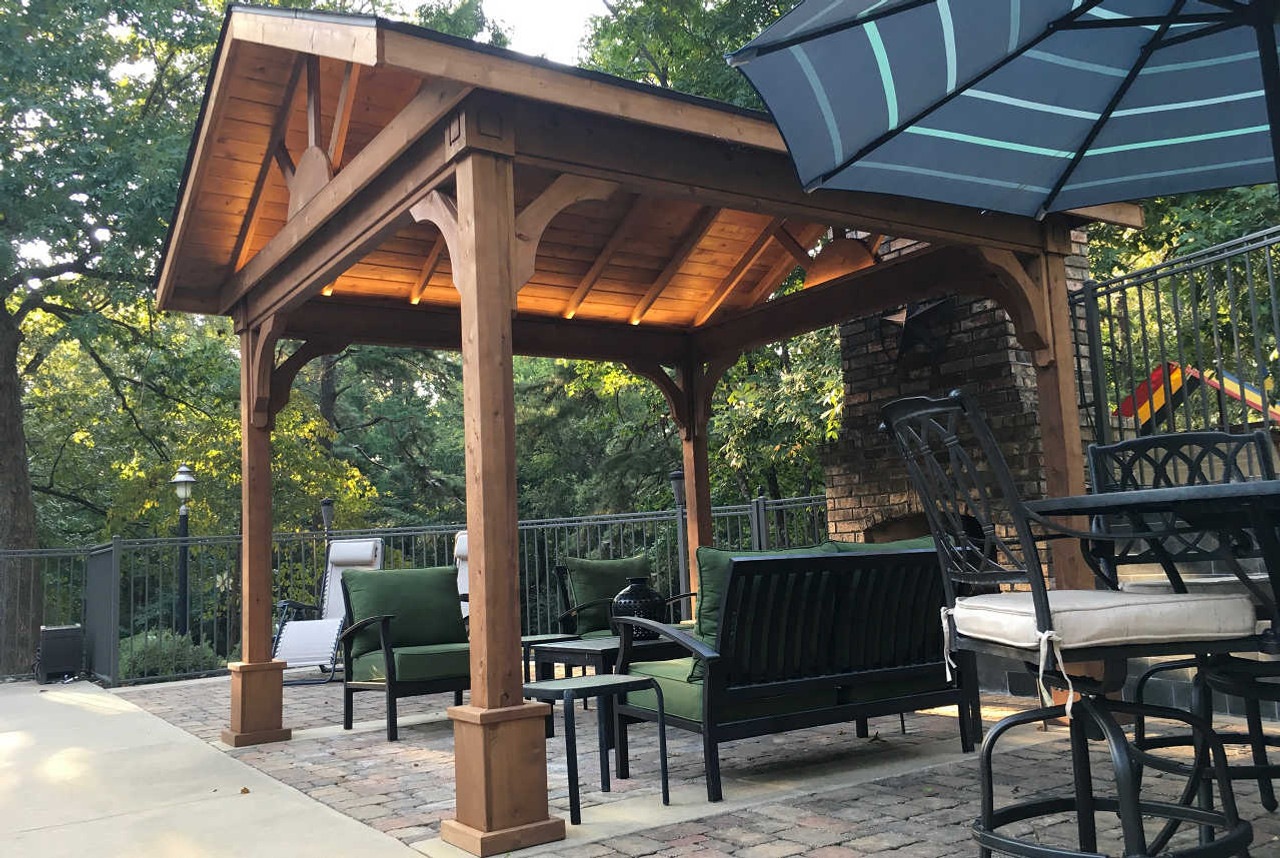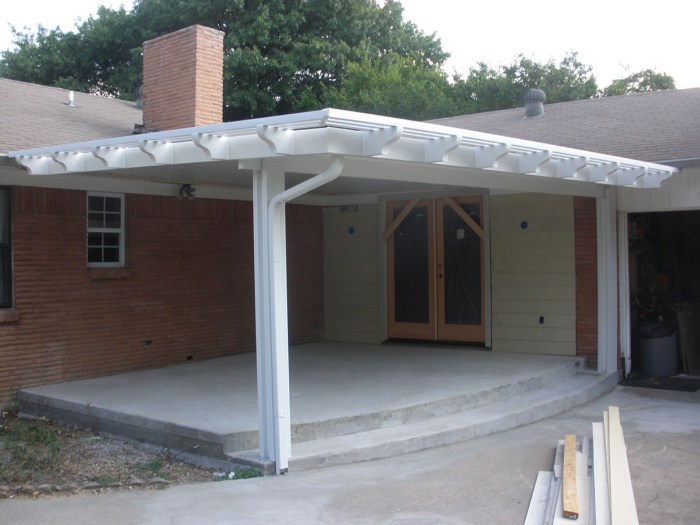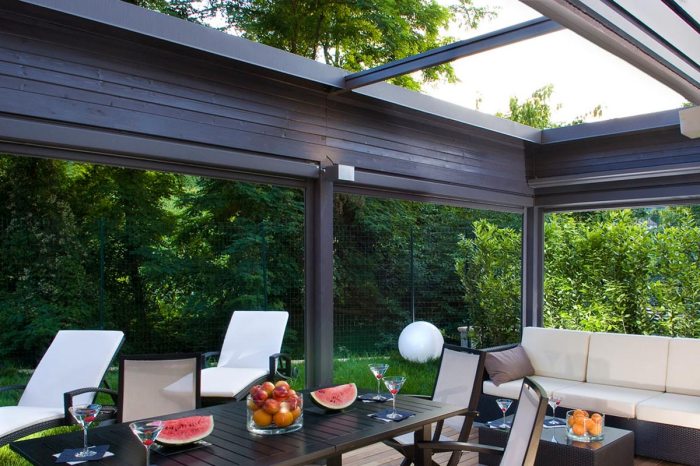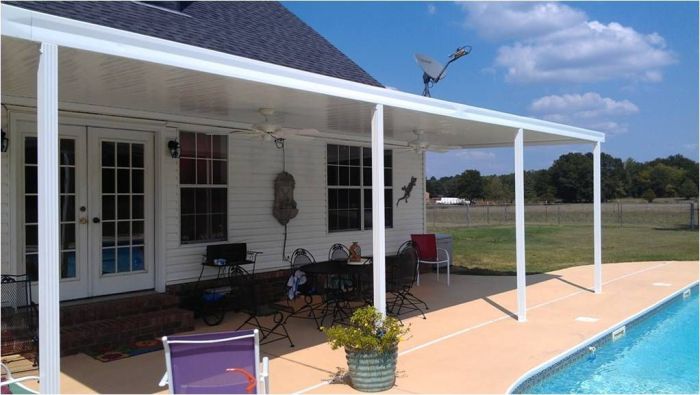Step into the realm of prefab patio covers, where outdoor living takes center stage. This comprehensive guide invites you on a journey of discovery, empowering you with knowledge and inspiration to transform your backyard into an oasis of comfort and style.
From exploring diverse designs and materials to understanding installation and maintenance, this guide is your trusted companion, ensuring your prefab patio cover seamlessly complements your home and lifestyle.
Introduction
Prefab patio covers are a great way to add extra living space to your home while also protecting your patio from the elements. They come in a variety of styles and materials, so you can find one that perfectly matches your needs and taste.
Prefab patio covers are typically made from aluminum, vinyl, or wood. Aluminum patio covers are lightweight and durable, and they come in a variety of colors. Vinyl patio covers are also durable, and they are resistant to fading and mildew.
Wood patio covers are a classic choice, and they can be stained or painted to match your home’s exterior.
Factors to Consider When Choosing a Prefab Patio Cover
When choosing a prefab patio cover, there are a few factors to consider:
- The size of your patio.You need to make sure that the patio cover you choose is the right size for your patio. If it’s too small, it won’t provide adequate coverage. If it’s too large, it will be overwhelming and expensive.
- The style of your home.You want to choose a patio cover that complements the style of your home. If you have a traditional home, you might choose a wood patio cover. If you have a modern home, you might choose an aluminum patio cover.
- The climate in your area.If you live in an area with a lot of rain or snow, you need to choose a patio cover that is durable and weather-resistant.
- Your budget.Patio covers can range in price from a few hundred dollars to several thousand dollars. It’s important to set a budget before you start shopping so that you don’t overspend.
Materials and Construction
Prefab patio covers are constructed using a variety of materials, each with its unique advantages and disadvantages.
Materials
- Aluminum:Lightweight, durable, and resistant to corrosion, making it a popular choice for low-maintenance patio covers.
- Vinyl:Affordable, versatile, and available in a wide range of colors and styles, making it a cost-effective option for homeowners.
- Wood:Natural, aesthetically pleasing, and customizable, but requires regular maintenance to prevent rot and decay.
- Steel:Strong, durable, and fire-resistant, making it a good choice for areas with high winds or extreme weather conditions.
- Fabric:Lightweight, portable, and provides shade from the sun, but may not be as durable as other materials.
Construction
The construction process of a prefab patio cover typically involves the following steps:
- Planning and Design:Determine the size, shape, and style of the patio cover, as well as the materials to be used.
- Foundation:Install support posts or footings to create a stable base for the patio cover.
- Framing:Assemble the framework of the patio cover using beams, rafters, and purlins.
- Roofing:Install the roofing material, such as shingles, tiles, or metal, to provide protection from the elements.
- Finishing:Add finishing touches, such as gutters, downspouts, and lighting, to complete the installation.
Durability and Maintenance
Prefab patio covers are generally durable and low-maintenance, but the specific requirements vary depending on the materials used.
- Aluminum:Requires minimal maintenance, such as occasional cleaning, and is resistant to rust and corrosion.
- Vinyl:Requires regular cleaning to prevent dirt and mildew buildup, and may fade over time.
- Wood:Requires regular maintenance, such as staining or painting, to prevent rot and decay.
- Steel:Requires occasional painting or touch-ups to prevent rust, but is generally very durable.
- Fabric:Requires regular cleaning and may need to be replaced periodically depending on the usage and weather conditions.
Design and Aesthetics
Prefab patio covers offer a diverse range of design styles to complement any home. From classic and traditional to modern and contemporary, there is a style to suit every taste and architectural preference.
To choose a prefab patio cover that harmonizes with your existing home design, consider the overall architectural style, roofline, and exterior finishes. For instance, a traditional home may benefit from a pitched roof patio cover with decorative columns, while a modern home might opt for a sleek and minimalist design with clean lines and geometric shapes.
Incorporating into Landscape Design
A well-designed prefab patio cover can seamlessly integrate into the surrounding landscape. By considering factors such as the location, orientation, and surrounding vegetation, you can create a cohesive and inviting outdoor living space.
For instance, placing the patio cover near a garden or water feature can create a tranquil and serene ambiance. Alternatively, orienting the cover to take advantage of natural shade from trees or existing structures can reduce energy consumption and enhance comfort during hot weather.
Installation and Assembly
Installing a prefab patio cover is a straightforward process that can be completed in a few hours. However, it’s important to follow the manufacturer’s instructions carefully to ensure a secure and long-lasting installation.
The first step is to prepare the site by clearing away any debris or obstacles. You will then need to assemble the frame of the patio cover according to the instructions. Once the frame is assembled, you will need to attach the roofing panels.
Finally, you will need to seal the seams and edges of the patio cover to prevent leaks.
Tools and Materials
The following tools and materials are required for installing a prefab patio cover:
- Cordless drill
- Drill bits
- Wrench
- Screwdriver
- Level
- Measuring tape
- Caulk gun
- Caulk
- Prefab patio cover
- Concrete anchors (if installing on a concrete surface)
Importance of Proper Installation and Maintenance
It is important to properly install and maintain your prefab patio cover to ensure its longevity and safety. A properly installed patio cover will provide years of protection from the sun and rain. It will also help to extend the life of your patio furniture and other outdoor belongings.
To maintain your patio cover, simply clean it regularly with a mild soap and water solution. You should also inspect it periodically for any damage and make repairs as needed.
Benefits and Applications
Installing a prefab patio cover offers numerous advantages, enhancing the functionality and aesthetic appeal of your outdoor space. These covers provide protection from the elements, extend the usable area of your patio, and create a comfortable and inviting environment.
Prefab patio covers are versatile and can be used for a wide range of applications, including:
Outdoor Dining
- Protect your dining area from sun, rain, and wind, allowing you to enjoy meals outdoors regardless of the weather.
- Create a shaded and comfortable space for family gatherings, barbecues, and special occasions.
Relaxation
- Provide a sheltered spot to unwind and relax in your backyard, away from the sun’s glare and rain.
- Create a cozy and private retreat for reading, napping, or simply enjoying the outdoors.
Entertainment
- Extend your living space by creating an outdoor entertainment area for parties, movie nights, or sports viewing.
- Protect your guests and equipment from the elements, ensuring a comfortable and enjoyable gathering.
Case Study
Homeowner Jane Smith installed a prefab patio cover over her outdoor dining area. “It has transformed our backyard into an extension of our home,” she says. “We can now enjoy meals and family gatherings outdoors without worrying about the weather.
It’s like having another room in our house.”
Cost and Value
Prefab patio covers offer a balance of affordability and value, making them an attractive option for homeowners. The cost of purchasing and installing a prefab patio cover varies depending on several factors.
The size, style, and materials used in the construction of the cover are the primary cost determinants. Larger covers and those made from premium materials, such as aluminum or cedar, will typically cost more than smaller covers made from basic materials, such as vinyl or polycarbonate.
Factors Affecting Cost
- Size of the cover
- Style and design complexity
- Materials used
- Local labor costs
- Permits and inspections
The return on investment for a prefab patio cover can be substantial. A well-designed and installed cover can increase the value of a property by providing additional living space, protection from the elements, and enhanced curb appeal.
Closing Summary: Prefab Patio Cover
As you embark on this transformative journey, remember that a prefab patio cover is not merely an addition to your home; it’s an extension of your living space, a sanctuary where memories are made and moments are cherished. Embrace the possibilities and let your outdoor dreams take flight.




